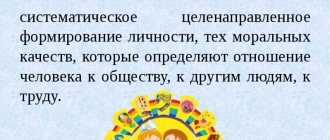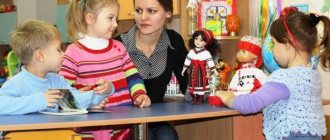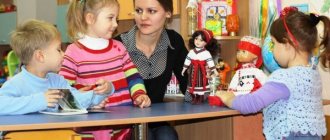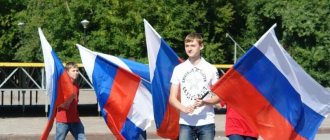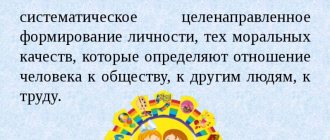Directions of moral development of preschool children
Definition 1
Moral development is the formation in a person of basic moral properties, a meaningful perception of his own personality and its place in the social environment, an understanding of his purpose and the need for continuous improvement of his personality.
Moral development is carried out in the course of moral education.
Moral education is the individual’s assimilation of the fundamentals of morality, the development of moral guidelines for behavior, the assimilation of the fundamentals of the moral functioning of society and the behavioral habits inherent in it.
Moral education is based on moral norms and principles of social behavior. It reflects the continuity of generations and the transfer of social experience.
Are you an expert in this subject area? We invite you to become the author of the Directory Working Conditions
Figure 1. Moral education. Author24 - online exchange of student work
If moral norms are a social category, i.e. they reflect the requirements of society for the behavior of an individual, his compliance with the norms of social interaction, then morality is an internal category, i.e. it is an internal regulator of individual behavior. The moral behavior of an individual in a social environment and its overall development depend on how developed this regulator is.
Moral education begins from an early age of a child. This is relevant because the behavioral habits formed in preschool age become stable foundations of human behavior throughout his life.
Finished works on a similar topic
Course work Moral education of preschool children 440 ₽ Abstract Moral education of preschool children 240 ₽ Test work Moral education of preschool children 200 ₽
Receive completed work or specialist advice on your educational project Find out the cost
The moral education of preschool children is aimed at the formation of an original personality with the skills of social interaction and self-control of behavior. The child must learn to control his actions and actions, express opinions, take into account the needs and interests of another person, develop adequate self-esteem and express his opinions and views, as well as constructively defend his interests in society.
The moral development of a preschooler is focused on the formation of his moral character. The main directions of moral development of a preschooler are:
- Formation of the pupil’s personal properties. It is necessary to create conditions for the disclosure of the natural inclinations of the individual and the disclosure of his potential.
- Moral development of personality. Here, the moral experience of a preschooler’s life is formed, and he masters the experience of social behavior and interaction.
- Developing an adequate attitude towards others: respect for other people’s opinions and points of view, acceptance of someone else’s point of view, different from one’s own, as correct, equality and equivalence of all participants in the social sphere of activity.
- Patriotic education. It is focused on the formation of civic qualities of an individual: love for the Motherland, respect for the customs and traditions of one’s people, awareness of one’s belonging to a particular culture.
- Mastering ethical standards of behavior. They reflect the values of the social environment and the rules of behavior in society, which are unspoken. They are based on the relationship between the interests of the individual and society.
In preschool age, the foundations of moral judgments and assessments are developed. The child comprehends them and learns to apply them in practical activities. In order for a child’s behavior to be formed on the basis of his conditioning by moral norms, it is necessary to organize a system of moral education that takes into account the age-related characteristics of the development of preschoolers and focuses on the social development of the pupil’s personality and his comprehensive humanistic development.
Theory and methodology of moral education of preschool children
Andreeva Yulia
Theory and methodology of moral education of preschool children
1. Theory and methodology of moral education
1.1. Objectives of moral education
In the context of the transition to the new Federal State of preschool education, the main tasks of the spiritual and moral education of preschool children :
-formation of the principles of patriotism and citizenship;
- formation of a humane attitude towards people and the environment;
- formation of spiritual and moral attitudes and a sense of belonging to the cultural heritage of one’s people;
-respect for your nation;
-understanding of one’s national characteristics;
- formation of self-esteem as a representative of one’s people;
-respect for representatives of other nationalities;
-formation of positive, friendly, collective relationships;
- fostering a respectful attitude towards work.
1.2 The mechanism of moral development of personality
The strength and stability of a moral quality depend on how it was formed, what mechanism was used as the basis for pedagogical influence. Let us consider the mechanism of moral development of personality. For the formation of any moral quality, it is important that it takes place consciously. Therefore, knowledge is needed on the basis of which the child will form ideas about the essence of moral quality , its necessity and the advantages of mastering it. The child must have a desire to master a moral quality , that is, it is important that motives arise for acquiring the corresponding moral quality . The emergence of a motive entails an attitude towards quality, which, in turn, shapes social feelings. Feelings give the formation process a personally significant coloring and therefore influence the strength of the emerging quality. But knowledge and feelings generate the need for their practical implementation - in actions and behavior. Actions and behavior take on the function of feedback, allowing you to check and confirm the strength of the quality being formed.
Thus, the mechanism of moral education : (knowledge and ideas)
+
(motives)
+
(feelings and attitudes)
+
(skills and habits)
+ +
(actions and behavior)
=
moral quality . This mechanism is objective in nature. It always manifests itself during the formation of any (
moral or immoral ) personality trait.
The main feature of the mechanism of moral education is the absence of the principle of interchangeability. This means that each component of the mechanism is important and can neither be excluded nor replaced by another. What, for example, will happen if we decide to form kindness as a moral quality of an individual and begin to instill in a child only ideas about what kindness is? Or will we not evoke a positive attitude towards this quality and the desire to master it, to become kind? Or will we not create conditions for the manifestation of kindness? Assignment: Try to explain what will happen to moral quality if one of the components is excluded. Is it possible to replace it with another component? At the same time, the action of the mechanism is flexible: the sequence of components can change depending on the specific quality (its complexity, etc.)
and on
the age of the object of education . It is clear that it is impossible to rely on understanding and awareness of the importance of developing one or another personality quality in a child of primary preschool age . But does this mean that the time has not yet come to educate him morally ?
Of course not. We need to change the sequence and start not with imparting knowledge, but with the formation of an emotional base and behavioral practice. This will serve as a favorable basis for subsequent knowledge acquisition. The first group of tasks of moral education includes the tasks of forming its mechanism: ideas, moral feelings , moral habits and norms , and behavioral practices. Each component has its own formation characteristics, but it must be remembered that this is a single mechanism and therefore, when forming one component, an influence on other components is necessarily expected.
Education is historical in nature, and its content changes depending on a number of circumstances and conditions: the demands of society, economic factors, the level of development of science, and the age capabilities of those being educated .
Consequently, at each stage of its development, society solves different problems of educating the younger generation, that is, it has different moral ideals of a person . , the education of collectivism became the most significant , in others - patriotism. Today, business qualities, entrepreneurship, etc. have become significant. And each time the ideal created by society has been extrapolated to preschool childhood , since the phrase “Everything begins with childhood”
not only journalistic and journalistic, it also has a deep scientific meaning and justification.
So, the second group of tasks of moral education reflects the needs of society for people who have specific qualities that are in demand today. If the first group of tasks is of a permanent, unchangeable nature, then the second is mobile. Its content is influenced by the historical stage, the age characteristics of the object of education , and specific living conditions. During the Soviet period, the tasks of moral education of preschoolers (for the second group)
were grouped into four semantic blocks.
It was necessary to educate : humane feelings and relationships; the beginnings of patriotism and internationalism; diligence, ability and desire to work; collectivism. At the present stage of development of our society, significant transformations in the formulation of semantic blocks, perhaps, have not occurred. They truly embrace all aspects of morality . But the specific content of each block and its meaning, of course, change and are clarified. to cultivate collectivism as a moral quality of modern man is being questioned education , and the view on patriotic and international education . However, these aspects do exist in the moral structure of the individual and therefore cannot be excluded.
1.3 Means and methods of moral education .
Moral education is carried out using certain means and methods .
Means of moral education of preschool children can be combined into several groups.
Fiction, visual arts, music, cinema, filmstrips and other media can be combined into a group of artistic media. This group of means is very important in solving problems of moral education , as it contributes to the emotional coloring of cognizable moral phenomena. Numerous studies (N. S. Karpinskaya, L. N. Strelkova, A. M. Vinogradova)
show that children vividly, emotionally and trustingly
perceive fairy tales , poems, stories read to them, and look at illustrations for books (V. A. Eliseeva, G. N. Panteleev)
.
A child is strongly impressed by the work of artists if they depict the world realistically and understandably for a preschooler . Artistic means are most effective in forming moral ideas and cultivating feelings children .
The means of moral education of preschool children is nature . Nature makes it possible to evoke humane feelings in children , a desire to take care of those who are weaker, who need help, to protect them, and helps to build self-confidence in the child. The impact of nature on the moral sphere of children’s personality is multifaceted and, with appropriate pedagogical organization, becomes a significant means of educating feelings and behavior (S. N. Nikolaeva, L. G. Niskanen, V. G. Fokina, V. D. Sych)
.
The means of moral education of preschoolers children’s own activities : play, work, learning, artistic activity. Each type of activity has its own specifics, performing the function of a means of education , but this means - activity as such - is necessary, first of all, when developing the practice of moral behavior . A special place in this group of means is given to communication, if it is followed by psychologists (M. I. Lisina, A. G. Ruzskaya)
considered a type of activity.
Communication as a means of moral education best fulfills the task of adjusting ideas about morality and cultivating feelings and relationships .
The means of moral education can be the entire atmosphere in which the child lives: the atmosphere can be imbued with goodwill, love, humanity or cruelty, immorality . The environment surrounding the child becomes a means of educating feelings , ideas, behavior, i.e. it activates the entire mechanism of moral education and influences the formation of certain moral qualities .
The choice of means of education depends on the leading task, on the age of the students , on the level of their general and intellectual development, on the stage of development of moral qualities (we are just beginning to form a quality, or are consolidating it, or are already re-educating ). As you know, the remedy becomes effective in combination with adequate methods and techniques of education .
In pedagogy, there are several approaches to the classification of educational methods (Yu. K. Babansky, B. T. Likhachev, I. P. Podlasy - in general and school pedagogy; V. G. Nechaeva, V. I. Loginova - in preschool pedagogy ) . To classify methods, researchers determine one basis. Thus, Academician B. T. Likhachev proceeds from the logic of the integrity of the pedagogical process, as well as the logic of its organization when solving problems of moral education and self-education . According to this basis, he distinguishes three groups of methods : methods of organization and self-organization of the educational team (collective perspective, collective game, competition, common requirements); methods of trusting interaction ( method of respect , pedagogical requirement, persuasion, discussion, conflict situations); methods of influence (clarification, stress relief, dream actualization, appeal to consciousness, feeling, will and action). V. G. Nechaeva distinguishes two groups of methods of moral education of preschool children : organization of practical experience of social behavior ( training method , demonstration of action, example of adults or other children , method of organizing activities); moral ideas in (conversations, reading works of art, viewing and discussing paintings and illustrations). the method of persuasion , positive example, encouragement and punishment in both the first and second groups The classification proposed by V. I. Loginova is built on the same basis as that of V. G. Nechaeva - on activating the mechanism of moral education - but it is more complete. The author proposes to combine all methods into three groups .
1. Methods for developing moral behavior (training, exercise, activity management)
;
2. Methods of forming moral consciousness (beliefs in the form of explanation, suggestion, conversation)
;
3. Methods of stimulating feelings and relationships (example, encouragement, punishment)
.
It is probably possible to choose other bases for classifying methods of moral education , although the most appropriate is the one that corresponds to its mechanism. the methods are , they give effective results only under certain conditions. Any method (group of methods )
must be humane, not humiliating the child, not violating his rights.
This applies to children of any age—infancy , preschool , and school; - the method must be real, feasible, it requires a logical conclusion. Sometimes educators and parents use the technique of promising a reward without thinking about whether it is real. And they don't deliver what they promised. What result can be obtained in the moral development of a child? Or, as often happens, a threat is used as punishment (which in itself is bad and has nothing to do with the method of anticipating the consequences of an act or action). Parents threaten the child with something that they will never actually do ( “If you don’t listen, I’ll take you into the forest and leave it to the wolves!”
).
At first, such threats may have results, but gradually the child will learn that there is nothing behind such words and that one can continue to disobey. In moral education, each method must be weighty and significant; — to use the method , conditions and means must be prepared in advance. For example, a teacher teaches children to take care of things and toys and for this he wants to use a method of organizing children’s joint activities - to organize a “toy repair workshop
.
In this case, he must prepare materials with which the children could work; — the method should not be applied in the same way, stereotyped way to all children and in any situation. If this condition is not observed, the method of persuasion may turn into edification and cease to bring the desired result; — education methods should be used tactfully. The pupil should not feel that he is being raised . Indirect influence is a great art, which a teacher masters if he knows how to treat a child with care. When selecting methods, the degree of complexity of the quality being formed should be taken into account. When designing and selecting methods , it is important to foresee the possible results of their impact on a particular child. If the teacher is not confident of success or anticipates too strong a reaction, the chosen method should be abandoned ; — the use of moral education methods requires patience and tolerance. When it comes to a preschool , you cannot count on instant and permanent results. We should patiently repeat the methods already used and select new ones , with an understanding that the result will not be achieved immediately and, perhaps, not quite in the form and quality that we expect; — methods that involve teaching the child methods of action should be the moral education of preschoolers If you only rely on awareness, understanding the significance of positive behavior and do not teach ways of such behavior, the desired results will not happen. So, let's turn to the well-known method of using an adult as a role model. to count on the impact of this method without organizing observation, as well as practicing the child’s behavior. The positive actions of an adult in themselves do not guarantee the same actions in a child; - methods are not used in isolation, but in combination, in interconnection. The basis for selecting methods that can and should be used in combination is the leading educational task and the age of the children .
1.4. Contents and methods of moral education of children of early preschool age .
Success in raising a free personality , and this is exactly the kind of personality we want to get, depends on the initial methodological position from which we look at the child. If you ask any person (be it a mother, father, teacher, etc. , whether he wants us to raise a happy child , he will probably be surprised at first, and then answer in the affirmative. Never in our domestic preschool of raising a happy child been set . Or maybe a young teacher should think about this? Think about how to change their view of the child and their role in his development. In American pedagogy there is such a principle - “ raise a happy personality "
.
A person should be because he was born, because he lives. Domestic concept: when raising a child , we seem to build a perspective for him: if you obey your elders, if you study well, etc., you will become a happy person. But the Americans “turned everything upside down”
: you were born a happy person and therefore you can study well, live happily, you will succeed, you can handle everything.
What moral qualities should a child have in order to feel happy? And is it really possible to contribute to the formation of a happy personality through pedagogical influences? There are many qualities that can be identified that make up the image of a happy child. A happy child is confident in himself, he communicates easily and with pleasure, openly and trustingly with people - adults and children. He is optimistic and takes everything with joy . He is inquisitive, etc. But to raise such a child if both parents and educators are imbued with deep respect for the child’s personality and teach him something very important: self-esteem and the ability to live among people.
The content of moral education of preschoolers includes the following semantic blocks:
— education of humanity as a personality quality;
— education of collectivism;
— formation of the principles of citizenship and patriotism;
- formation of an attitude towards work and diligence.
Education of humanity is the formation of such a moral quality , which implies sympathy, empathy, responsiveness, empathy.
The core and indicator moral education is the nature of his attitude towards people, nature, and himself. Research shows that such attitudes can develop in children as early as preschool age . The basis of this process is the ability to understand another, to transfer the experiences of another to oneself.
The formation of a humane attitude towards people and nature begins in early childhood. With systematic work aimed at nurturing a humane attitude of preschoolers towards the people around them and nature, children develop humanism as a moral quality . In other words, humanism is included in the structure of personality as its qualitative characteristic.
It should be emphasized that the education of humane feelings and attitudes is a complex and contradictory process. The skills to sympathize, empathize, rejoice, not envy, and do good sincerely and willingly are only developed in preschool age .
The education of collectivism as a moral quality of a preschooler is based on the formation of positive, friendly, collective relationships.
The main and only function of the children's team is educational : children are included in activities that, in terms of their goals, content and forms of organization, are aimed at shaping the personality of each of them.
For the education of collective relationships, the emergence of such a phenomenon as friendship has a meaning-forming significance. Friendship, as the closest connection between children, accelerates the process of effective awareness of social relationships. Mutual assistance and responsiveness are significant characteristics of collective relationships.
In groups of preschool children, there is a collective opinion. It not only manifests itself in the form of identical ideas about the norms of relationships, but can also be actively used as a personally significant factor of influence on each member of the team and as the basis of collective relationships.
Children's relationships are governed by moral rules and norms . Knowing the rules of behavior and relationships makes it easier for a child to enter the world of his own kind, the world of people.
Nurturing the principles of patriotism and citizenship is one of the most important components of the moral education of preschoolers .
The feeling of love for the Motherland is akin to the feeling of love for one’s home. These feelings are related by a common basis - affection and a sense of security. This means that if we cultivate in children a sense of affection, as such, and a feeling of attachment to their home, then with appropriate pedagogical work, over time it will be complemented by a feeling of love and affection for their country.
The feeling of patriotism is multifaceted in its structure and content. It includes responsibility, desire and ability to work for the good of the Fatherland, to protect and increase the wealth of the Motherland, a range of aesthetic feelings, etc.
The process of moral formation of personality occurs unevenly. In each period of preschool time, the child reaches qualitatively new levels of moral development .
In early preschool age, the first ideas about what is good and what is bad arise. This occurs in the process of forming a new type of relationship between a child and an adult. The development of a child’s independence at this time is accompanied by the need for participation in the lives of adults and joint activities with them. The desire for positive assessment, support and approval of one’s actions contributes to organizing the process of a child’s assimilation of moral standards .
In middle preschool age, the “defender” is clearly manifested.
standards of behavior, the standard of which is an adult.
As a rule, in their complaints, children mainly report that one of their peers did not comply with the adult’s requirements or rules of behavior. The first stage in children’s of ideas about good and evil, how to behave with other people, how to relate to their own and others’ actions, is associated with a direct emotional attitude towards the people who make these demands.
In older preschool age, moral feelings and knowledge are associated with a sense of duty. A child at this age is able to realize the moral meaning of his behavior. Internal moral authorities emerge (L. Vygotsky)
- the desire to lead in accordance with moral standards, not because adults (parents,
educators ) demand it, but because it is pleasant for oneself and others.
During preschool childhood, internal qualities such as self-esteem develop. The child feels pride in a job well done, worthy deed, one's behavior in general. A feeling of shame also appears. The child finds himself in the awkwardness that he experiences from an unsuccessful action, his own guilt - first under the influence of an adult's remarks (“Shame on you!”, And in older preschool age it is combined with self-esteem and becomes stable ( “You shouldn’t do something bad not because you will be punished, but because you are ashamed”
). The child is also ashamed when his dignity is humiliated. To avoid shame and remorse from adults, he can refrain from actions that will cause condemnation.
formed in preschool age largely determine the future of his or her life, and it is difficult or impossible to correct mistakes made by parents and teachers in the moral education of children .
Tasks of moral education of preschool children
The moral education of preschool children is focused on developing their moral feelings, ideas and guidelines for social activity, as well as behavioral habits and motives for social activity.
The moral education of preschool children is focused on solving two groups of problems:
- Tasks for developing a mechanism for the moral development of a child. This group of tasks is permanent and sustainable. The mechanism of moral development is associated with the choice of forms, methods and technologies for organizing educational activities, aimed at developing moral ideals in students that correspond to a specific stage of socio-economic development of society.
- Tasks to develop certain qualities and social skills in an individual. These tasks reflect the need to achieve a certain level of development of society and meet its needs. At every historical stage in the development of society, it requires people endowed with certain qualities. Therefore, the tasks of this group change in accordance with the dynamics of the development of the social environment.
Moral education of preschoolers is focused on:
- Education of the fundamentals of cultural behavior and cultural interaction in the social environment;
- Developing collective interaction skills;
- Education of the fundamentals of humanism and humane qualities of the individual;
- Fostering hard work;
- Nurturing patriotic qualities.
